Modelling Chapter Notes | Artificial Intelligence (AI) for Class 9 PDF Download
AI, ML & DL
- Artificial Intelligence (AI) is a broad field that encompasses various techniques and methods aimed at enabling machines to perform tasks that typically require human intelligence. AI can involve anything from simple rule-based systems to complex algorithms that learn and adapt over time.
- Machine Learning (ML) is a subset of AI that focuses on the idea that machines can learn from data and improve their performance over time without being explicitly programmed. In ML, algorithms are trained on data, allowing them to make predictions or decisions based on new, unseen data.
- Deep Learning (DL) is a further specialization within ML that involves neural networks with many layers (hence "deep"). DL is particularly effective for processing large volumes of data and is used in applications such as image and speech recognition, natural language processing, and more. In DL, the system can automatically discover patterns and features in the data, enabling it to learn and make decisions with minimal human intervention.
- In summary, while AI is the overarching field, ML is a subset of AI, and DL is a subset of ML. DL represents the most advanced and specialized form of AI among the three, with AI covering a wide range of techniques that mimic human intelligence in various ways.
- AI is the broadest category, encompassing any technique that enables computers to perform tasks that would typically require human intelligence. ML is a subset of AI that focuses on the ability of machines to learn from data and improve their performance over time. DL is a further specialization within ML that uses neural networks with many layers to process large amounts of data and automatically discover patterns and features.
Modelling
Purpose: To classify models into the Rule-based approach and Learning approach.
Say: “There are generally two approaches taken by researchers when building AI models: the rule-based approach and the learning approach. A rule-based approach relies on the data and rules fed to the machine, which reacts accordingly to deliver the desired output. In contrast, the learning approach involves feeding the machine data and the desired output, allowing the machine to design its own algorithm or set of rules to match the data to the desired output.”
- AI Modeling involves developing algorithms, also known as models, that can be trained to produce intelligent outputs. Essentially, it means writing code to make a machine artificially intelligent.
- In the previous module on Data Exploration, we explored various types of graphical representations used to depict different data parameters. These graphical representations help humans understand data by revealing trends and patterns. However, when machines access and analyze data, they require it in its most basic form, which is binary (0s and 1s). To discover patterns and trends, machines use mathematical representations of the data. The ability to mathematically describe the relationship between parameters is fundamental to every AI model. Therefore, when we discuss developing AI models, we are referring to the mathematical approach to data analysis.
Generally, AI models can be classified as follows:
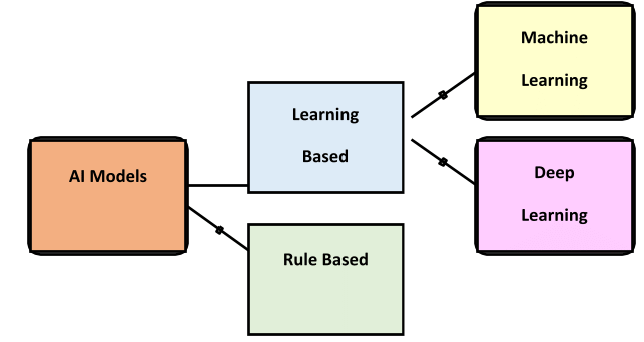
Rule-Based Approach in AI
- The rule-based approach in AI involves creating models where the rules are set by the developer. In this method, the machine follows the specific rules and instructions given to it and performs tasks accordingly.
- For instance, consider a dataset that helps determine whether a child can go out to play golf based on certain conditions. The parameters involved are Outlook, Temperature, Humidity, and Wind. Let's explore different scenarios for these parameters to see when children can play golf and when they cannot.
- After analyzing all the cases, this data is fed into the machine along with the rules that outline all possible situations. The machine trains on this data and prepares for testing. During testing, if we provide the machine with specific conditions like Outlook: Overcast, Temperature: Normal, Humidity: Normal, and Wind: Weak, it will predict whether the child can go out to play golf or not.
- This process is called the rule-based approach because we provide the machine with data and rules, and after training, it can make predictions. One characteristic of this approach is that the learning is static. Once the machine is trained, it does not consider any changes made to the original training data.
Learning Based Approach
The Learning-Based Approach in AI refers to a method where machines learn and adapt by themselves from the data provided to them. In this approach, the AI model is trained on a specific dataset, and once trained, it can adjust and modify its algorithms based on changes in the data. This means that if the model is initially trained on a certain type of data (let's say, images of apples and bananas), it can later adapt to new variations and exceptions in that data.
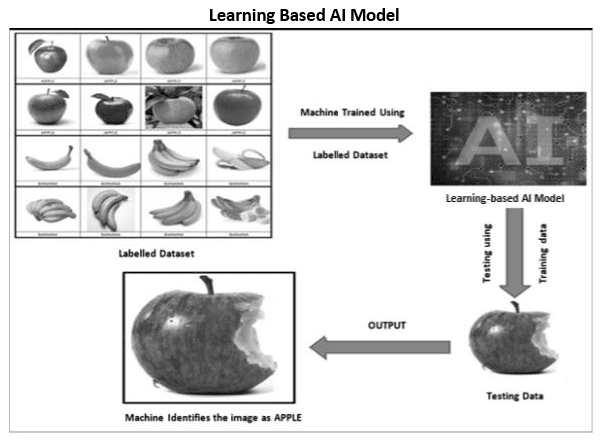
Example: Imagine you have a dataset with 100 images each of apples and bananas, showing them in different shapes and sizes. These images are labeled correctly: 'apple' for apple images and 'banana' for banana images. When the AI model is trained on this dataset, it learns to distinguish between apples and bananas based on their features.
Now, when the model is tested with new images that it hasn’t seen before, it uses the features it learned during training to identify whether an image is of an apple or a banana, even if the new images are different from the ones in the training set. This ability to adapt to new data while relying on learned features is what characterizes the Learning-Based Approach in AI.
Evaluation
What is Evaluation?
Evaluation is a crucial step in the process of developing an AI model. It involves testing the model's reliability by feeding it a test dataset and comparing the outputs with the actual answers. There are different evaluation techniques depending on the type and purpose of the model.
- Importance of Evaluation: It is essential to evaluate the model using a different dataset than the one used for training. Using the training data for evaluation can lead to overfitting, where the model simply memorizes the training set and predicts the correct labels without.
- Testing Data: The model is tested with the help of testing data that was separated from the acquired dataset during the data acquisition stage. The efficiency of the model is calculated based on various parameters.
- Purpose of Testing: Testing models helps check their performance and improve them for better results. It also ensures that the model is solving the identified AI problem effectively.
Evaluation Terminologies in Model Building
In the context of evaluating a model, there are several new terminologies that come into play. Let's explore these terminologies using an example of a forest fire scenario.
The Scenario
Consider a situation where you have developed an AI-based prediction model deployed in a forest prone to forest fires. The model's objective is to predict whether a forest fire has occurred or not. To understand the model's efficiency, we need to check the accuracy of its predictions. This brings us to two crucial aspects: Prediction and Reality.
Prediction refers to the output generated by the machine, while Reality represents the actual situation in the forest at the time of the prediction. Now, let's examine the various combinations that can arise from these two conditions.
Understanding the Results
Case 1: Forest Fire Detection
- In the first scenario, the model accurately predicts the presence of a forest fire based on the images provided. This is a case of True Positive, where the model's prediction aligns with the reality.

Case 2: Forest Fire Detection
- In the second scenario, the model continues to demonstrate its predictive capabilities.

Case 3: False Positive
- In the third scenario, the reality is that there is no forest fire, but the model incorrectly predicts one. This situation is known as a False Positive, where the model's prediction does not match the actual situation.

Case 4: False Negative
- In the fourth scenario, a forest fire is indeed occurring, but the model fails to recognize it and predicts otherwise. This is an example of a False Negative, where the model misses a critical event.

Evaluating Model Performance
At this stage, it becomes essential to evaluate the model's performance and determine which algorithm is making the best predictions. Various algorithms can be assessed for their accuracy in predicting outcomes.
- ROC (Receiver Operating Characteristic) is a metric used to evaluate the accuracy of a model. It helps in understanding how well the model can differentiate between different classes or outcomes.
- The graph comparing the accuracy of different algorithms, including BLS (Broad Learning System), MLP (Multi-Layer Perceptron), CNN (Convolutional Neural Network), Wavelet MLP (Wavelet Multi-Layer Perceptron), and SVM (Support Vector Machine), provides insights into which algorithm might be the most suitable for the specific use case of forest fire detection.
- While these algorithms are advanced topics within the curriculum, learners are encouraged to explore them further through online resources to gain a deeper understanding of their applications and functionalities.
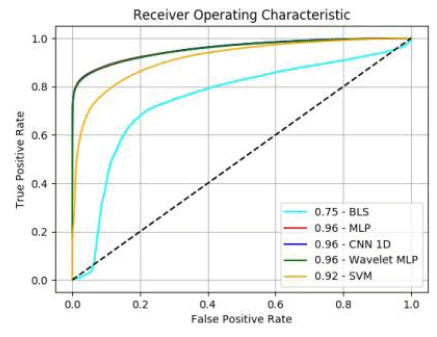
Deployment of AI Projects
What is Deployment?
Deployment refers to the final stage in the AI project cycle where the AI model or solution is implemented in a real-world scenario. It involves taking the developed and validated AI system and putting it into operation in a suitable environment where it can perform the intended tasks.
Key Steps in the Deployment Process
- Testing and Validation: Before deploying the AI model, it is crucial to test and validate its performance to ensure it meets the desired criteria and functions as expected in real-world conditions.
- Integration: The AI model needs to be integrated with existing systems and infrastructure to ensure seamless operation and data flow. This may involve connecting the model to databases, APIs, and other software applications.
- Monitoring and Maintenance: Once deployed, the AI model requires continuous monitoring to track its performance and identify any issues that may arise. Regular maintenance is also necessary to update the model and ensure it adapts to changing conditions.
Examples of Successful AI Deployments
- Self-Driving Cars: Companies like Tesla and Waymo have successfully deployed AI systems in self-driving cars, where the AI models are integrated with various sensors and cameras to navigate and drive safely in real-world conditions.
- Medical Diagnosis Systems: AI models are being used in hospitals and clinics to assist doctors in diagnosing medical conditions by analyzing medical images and patient data. These systems are integrated with existing healthcare infrastructure for seamless operation.
- Chatbots: Many businesses have deployed AI-powered chatbots on their websites and mobile apps to assist customers with queries and support. These chatbots are integrated with customer service systems and continuously monitored for performance.
Applications of AI
- Mobile Apps: AI can be integrated into mobile applications to provide various functionalities such as personalized recommendations, voice recognition, and image processing. Examples include AI-powered photo editing apps and virtual personal assistants.
- Website Apps: AI can be used in web applications to enhance user experience and automate tasks. Examples include AI-driven content recommendations, chatbots for customer support, and predictive analytics for business insights.

Case Study: Preventable Blindness

Problem: Prevent loss of vision, and delay in report generation
- Around 537 million adults aged 20 to 79 are living with diabetes.
- Diabetes can cause Diabetic Retinopathy, which damages the blood vessels in the retina, leading to blurred vision and potential blindness.
- A shortage of qualified doctors and delays in report generation increase the risk of Diabetic Retinopathy.
- One of the early symptoms of this condition is blurred vision.

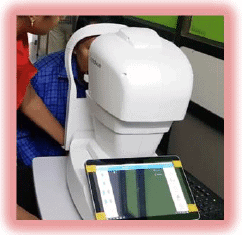
How AI Can Solve the Problem of Diabetic Retinopathy Detection
The Problem: Diabetic Retinopathy
- Diabetic Retinopathy is a serious eye condition that can lead to blindness, especially in people with diabetes.
- It occurs when high blood sugar levels damage the blood vessels in the retina, the light-sensitive tissue at the back of the eye.
- Early detection is crucial to prevent vision loss, but many people, especially in rural areas, do not have access to specialized eye care.
The AI Solution at Aravind Eye Hospital, India
- Development and Partnership: An AI eye screening solution was developed in partnership with Google to detect Diabetic Retinopathy in images of the eye.
- Accuracy: AI models have achieved an impressive accuracy of 98.6% in detecting diabetic retinopathy, which is comparable to the expertise of specialist eye doctors.
- Implementation: The solution is being used in seventy-one vision centers in rural Tamil Nadu, India.
- Process: Trained technicians capture digital images of patients’ eyes using cameras, and the AI analyzes these images for signs of Diabetic Retinopathy.
- Speed and Accessibility: AI has significantly sped up the detection process, making it possible for any technician to use the system without needing a skilled doctor on-site.
- Benefits: Early detection through this AI system allows for timely treatment, benefiting rural populations where access to healthcare is limited.
AI Project Cycle Mapping
- Problem Scoping: The issue at hand is the preventable blindness caused by Diabetic Retinopathy.
- Exploration: Data is being collected from patients across various clinics using retinal cameras.
- Data Validation: The collected data is validated to ensure its relevance and accuracy, forming the basis for model development.
- AI Model Creation: An AI model is being developed to accurately diagnose Diabetic Retinopathy from retinal images.
- Testing and Fine-Tuning: The model undergoes testing for accuracy and further fine-tuning to improve output quality.
- Implementation: The model will be integrated into tools that can be used in clinics, even in remote and rural areas of the country.
AI Project Cycle Mapping Template for Preventable Blindness
Fill out the AI Project Cycle mapping template for the issue of personalized education discussed earlier. You can use the provided AI Project cycle mapping template as a reference.
Personalised Education refers to tailoring educational experiences to suit the unique needs, abilities, and interests of individual students. This approach allows students to learn at their own pace, focus on areas where they need more support, and ultimately enhances their engagement and academic performance.
Ethics and Morality
Ethical Questions: Examples and Scenarios
Ethical questions are inquiries that challenge our understanding of what is right and wrong in a given situation. They often involve dilemmas where the choices are not clear-cut and require careful consideration of the implications of each action. Here are some examples of ethical questions:
- The Shopkeeper Dilemma: If a shopkeeper accidentally gives me more change than I am owed, should I return the extra money, or is it acceptable to keep it?
- Library Pens: Is taking pens from a library considered stealing, or are they free for public use?
- Restaurant Napkins: Is taking extra paper napkins from a restaurant without permission considered theft?
- Online Shopping Returns: If I order a dress from Amazon and wear it once for a friend's birthday party before returning it with the excuse of improper fitting, is this ethical?
Moral Questions: Definition and Examples
Moral questions pertain to the principles of right and wrong behavior that guide individuals in their actions. These questions often explore the nuances of honesty, fairness, and societal norms. Here are some examples of moral questions:- The Nature of Lying: Is it acceptable to lie in certain situations? If so, what are those situations?
- Stealing for Survival: If a family is starving and has no other means to obtain food, is it morally justifiable to steal food from a wealthy store owner? Why or why not?
- Collective Decision-Making: Is a decision made by a group of people always the right one, or can it be wrong?
- Understanding Ethics: What does ethics mean to you?
- Understanding Morals: What do morals mean to you?
- Comparing Ethics and Morals: Did you observe any differences or similarities between ethical and moral questions?
Major Issues around AI Ethics
Who is Jack?
- Jack is an average middle school student.
- His school recently started using an AI-based essay grading system that evaluates and assigns grades to essays.
Jack's Concern:
- Jack is worried that he received a bad grade on his essay, despite believing he wrote a really good one.
Ethics vs Morals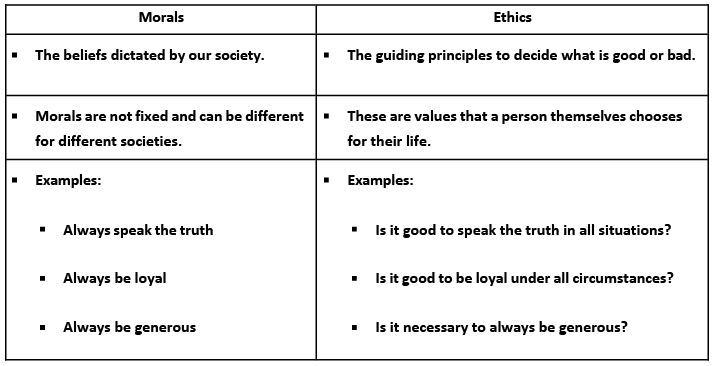
Principles of AI Ethics
Identifying the PrinciplesTo improve AI, we must identify the factors that impact its quality. The following principles in AI Ethics are crucial for ensuring high-quality AI solutions:
- Human Rights: AI should respect and uphold human rights.
- Privacy: AI must protect individuals' privacy.
- Inclusion: AI should be inclusive and not discriminate against any group.
AI Ethics Principles in Detail:
1. Human Rights
- AI solutions must respect human rights, including:
- Freedom: Ensure AI does not restrict individual freedoms.
- Non-Discrimination: AI should not discriminate against any group of people.
- Job Protection: AI should not deprive people of their jobs.
2. Bias and Data Representation
- Bias in AI often comes from the data used to train it. To avoid bias, consider:
- Data Representation: Ensure your data represents all sections of the population equally.
- Discrimination: Avoid training AI to discriminate against certain groups.
- Inclusion: Ensure no groups are excluded from the AI's learning process.
3. Privacy
- AI solutions must prioritize privacy by:
- Data Protection: Safeguarding personal data from unauthorized access.
- Consent: Obtaining consent for data collection and usage.
- Transparency: Being transparent about data usage practices.
Artificial Intelligence (AI) has the potential to bring about significant positive changes in our lives. However, it is essential to establish guidelines to ensure that AI is developed and used responsibly and ethically.
Here are some important guidelines for responsible AI development.
- Privacy Protection: AI systems must prioritize the protection of individuals' privacy. This includes obtaining informed consent before collecting personal data and being transparent about how this data will be used.
- Non-Discrimination: AI should not discriminate against any group of people. It is crucial to ensure that AI systems treat all individuals fairly and do not disadvantage specific populations.
- Inclusivity: AI should be designed to benefit everyone, regardless of their background or circumstances. Developers should consider how to make AI more inclusive and accessible to all.
- Safety and Security: AI systems must prioritize the safety and security of individuals. This includes safeguarding personal data and ensuring that AI technologies do not pose risks to users.
By following these guidelines, we can harness the potential of AI while safeguarding individuals' rights and promoting fairness and inclusivity.
1. Privacy Protection:
AI systems must prioritize the protection of individuals' privacy. This includes obtaining informed consent before collecting personal data and being transparent about how this data will be used.
- Informed Consent: AI developers should ensure that individuals are fully informed about what personal data will be collected, how it will be used, and for what purposes. Consent should be obtained voluntarily and without coercion.
- Data Transparency: AI systems should provide clear information to users about the data being collected, the methods used for data collection, and the purposes for which the data will be used. This transparency helps build trust between users and AI systems.
- Data Minimization: AI developers should collect only the data that is necessary for the intended purpose. Avoiding unnecessary data collection reduces privacy risks and ensures compliance with data protection regulations.
- Data Security: AI systems must implement robust security measures to protect personal data from unauthorized access, breaches, and cyberattacks. This includes encryption, access controls, and regular security audits.
- User Rights: Individuals should have the right to access, rectify, and delete their personal data collected by AI systems. Providing users with control over their data enhances privacy protection.
2. Non-Discrimination:
AI should not discriminate against any group of people. It is crucial to ensure that AI systems treat all individuals fairly and do not disadvantage specific populations.
- Bias Detection: AI developers should conduct thorough assessments to identify and mitigate biases present in training data and algorithms. This involves analyzing data for potential sources of bias and ensuring diverse representation in training datasets.
- Fairness Metrics: Implement fairness metrics to evaluate the impact of AI systems on different demographic groups. These metrics help measure whether certain groups are being unfairly treated or disadvantaged by the AI's decisions.
- Diverse Training Data: Use diverse and representative training data that reflects the variability of the population. This helps AI systems learn to make decisions that are fair and applicable to a broad range of individuals.
- Regular Audits: Conduct regular audits of AI systems to assess their performance and impact on different groups. Audits help identify any unintended consequences and allow for necessary adjustments to ensure fairness.
- Stakeholder Involvement: Involve stakeholders, including representatives from marginalized or disadvantaged groups, in the development and evaluation of AI systems. Their input can provide valuable insights into potential biases and fairness concerns.
3. Inclusivity:
AI should be designed to benefit everyone, regardless of their background or circumstances. Developers should consider how to make AI more inclusive and accessible to all.
- User-Centric Design: Involve diverse user groups in the design process to understand their needs, preferences, and challenges. User feedback ensures that AI systems are tailored to meet the requirements of various individuals.
- Accessibility Features: Incorporate accessibility features into AI applications to ensure that individuals with disabilities can use them effectively. This may include features like voice recognition, text-to-speech, and alternative input methods.
- Language and Cultural Sensitivity: Ensure that AI systems are capable of understanding and responding to users in multiple languages and cultural contexts. This promotes inclusivity and prevents alienation of specific user groups.
- Affordability: Consider the affordability of AI solutions to ensure that they are accessible to individuals from different economic backgrounds. Providing tiered pricing or free access options can enhance inclusivity.
- Community Engagement: Engage with communities to raise awareness about AI technologies and their benefits. Community outreach can help bridge the digital divide and ensure that marginalized groups are not left behind.
4. Safety and Security:
AI systems must prioritize the safety and security of individuals. This includes safeguarding personal data and ensuring that AI technologies do not pose risks to users.
- Data Protection: Implement robust data protection measures to safeguard personal information collected by AI systems. This includes encryption, access controls, and regular security audits to prevent data breaches.
- Risk Assessment: Conduct thorough risk assessments to identify potential safety and security risks associated with AI technologies. Anticipating and mitigating risks is crucial to ensure user safety.
- User Education: Educate users about the potential risks and safety measures associated with AI systems. Providing clear information helps users make informed decisions and use AI technologies safely.
- Incident Response: Develop incident response plans to address security breaches or safety incidents promptly. Having a clear plan in place minimizes the impact of incidents and ensures accountability.
- Compliance with Regulations: Ensure compliance with relevant regulations and standards related to data protection, privacy, and AI ethics. Adhering to legal requirements enhances trust and accountability.
|
32 videos|57 docs
|
FAQs on Modelling Chapter Notes - Artificial Intelligence (AI) for Class 9
| 1. What is the difference between AI, ML, and DL in the context of modeling? |  |
| 2. How do we evaluate the performance of AI models? |  |
| 3. What is the AI project cycle, and why is it important? |  |
| 4. What ethical considerations should be taken into account in AI projects? |  |
| 5. How can AI help in preventing blindness, and what modeling techniques are used? |  |
















